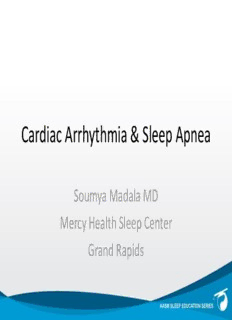
Cardiac Arrhythmia & Sleep Apnea PDF
Preview Cardiac Arrhythmia & Sleep Apnea
Cardiac Arrhythmia & Sleep Apnea Soumya Madala MD Mercy Health Sleep Center Grand Rapids Conflict of Interest Disclosures for Speakers X 1. I do not have any relationships with any entities producing, marketing, re- selling, or distributing health care goods or services consumed by, or used on, patients, OR 2. I have the following relationships with entities producing, marketing, re- selling, or distributing health care goods or services consumed by, or used on, patients. Type of Potential Conflict Details of Potential Conflict Grant/Research Support Consultant Speakers’ Bureaus Financial support Other 3. The material presented in this lecture has no relationship with any of these potential conflicts, OR 4. This talk presents material that is related to one or more of these potential conflicts, and the following objective references are provided as support for this lecture: Objectives • What happens during sleep • Who are the high risk patients • Arrhythmias in sleep apnea • What are we monitoring for What happens during sleep 2 easily measured parameters of the cardiovascular system • Heart rate • Blood pressure Both controlled by the Autonomic Nervous System 1. Parasympathetic 2. Sympathetic What happens during sleep • Parasympathetic Nervous System – Mediated by the Vagus nerve Cardiac muscarinic receptors • Causes bradycardia • Decreases cardiac muscle contraction What happens during sleep • Sympathetic Nervous System – Impulse carried by the thoracic and lumbar nerves • Constriction of blood vessels • Increased heart rate SA node • Increased cardiac muscle contraction direct effect on the cardiac muscle What happens during sleep At night On awakening Blood pressure dips by 10% Blood pressure raises Heart rate slows down Increased heart rate (effect of posture, activity level, Gradual steady increases noted circadian influence and effect of (effect of increasing activity, postural sleep) change) What happens during sleep • Non-REM stages – Parasympathetic influence is dominant • Heart rate is reduced bradycardia • Sinus pauses (over 2 seconds), AV blocks due to parasympathetic effect on AV node • Respiratory sinus arrhythmia indicates good cardiac health – HR accelerates with inspiration; decreases with expiration • No direct effect on Blood pressure • Effect most profound in slow wave sleep – Sympathetic activity reduced and stable • Reduced Blood Pressure What happens during sleep • REM stage – Predominant sympathetic state – Excitable and unstable state – significant fluctuations in heart rate, BP and respiration – Swings from tachycardia to bradycardia – Parasympathetic activity present but decreased What happens during sleep
Description: